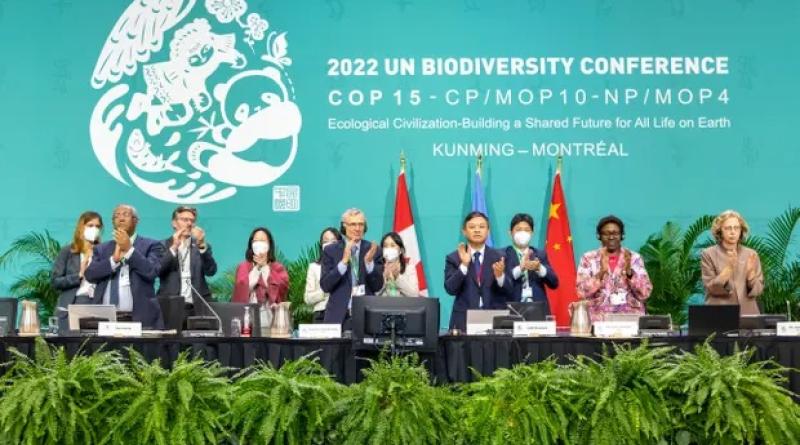Cop15: historic deal struck to halt biodiversity loss by 2030

Agreement on ’30 by 30’ target forced through by Chinese president, ignoring objections from African states
Cop15: key points of the nature deal at a glance
Governments appear to have signed a once-in-a-decade deal to halt the destruction of Earth’s ecosystems, but the agreement seems to have been forced through by the Chinese president, ignoring the objections of some African states.
After more than four years of negotiations, repeated delays due to the Covid-19 pandemic and talks into the night on Sunday in Montreal, nearly 200 countries – but not the US or the Vatican – signed an agreement at the biodiversity Cop15, which was co-hosted by Canada and China, to put humanity on a path to living in harmony with nature by the middle of the century.
In an extraordinary plenary that began on Sunday evening and lasted for more than seven hours, countries wrangled over the final agreement. Finally, at about 3.30am local time on Monday, news broke that an agreement had been struck.
The Democratic Republic of the Congo’s negotiator appeared to block the final deal presented by China, telling the plenary that he could not support the agreement in its current form because it did not create a new fund for biodiversity, separate to the existing UN fund, the global environment facility (GEF). China, Brazil, Indonesia, India and Mexico are the largest recipients of GEF funding, and some African states wanted more money for conservation as part of the final deal.
However, moments later, China’s environment minister and the Cop15 president, Huang Runqiu, signalled that the agreement was finished and agreed, and the plenary burst into applause.
Negotiators from Cameroon, Uganda and the DRC expressed incredulity that the agreement had been put through. The DRC said it had formally objected to the agreement, but a UN lawyer said it had not. The negotiator from Cameroon called it “a fraud”, while Uganda said there had been a “coup d’état” against the Cop15.
Amid plummeting insect numbers, acidifying oceans filled with plastic waste, and the rampant overconsumption of the planet’s resources as humanity’s population grows wealthier and soars past 8 billion, the agreement, if implemented, could signal major changes to farming, business supply chains and the role of Indigenous communities in conservation.
The deal was negotiated over two weeks and includes targets to protect 30% of the planet for nature by the end of the decade, reform $500bn (£410bn) of environmentally damaging subsidies, and restore 30% of the planet’s degraded terrestrial, inland water, coastal and marine ecosystems.
Governments also agreed urgent actions to halt human-caused extinctions of species known to be under threat and to promote their recovery.
The deal follows scientific warnings that humans are causing the start of Earth’s sixth mass extinction event, the largest loss of life since the time of the dinosaurs.
Canada’s Steven Guilbeault, a former environmental campaigner turned minister, said the Kunming-Montreal pact was a “bold step forward to protect nature”.
“Just six months ago, we didn’t know if we were going to even be able to have this conference and or even less to be able to adopt this historic document. And this was only possible through the collaboration of all countries present here tonight,” he said.
Governments have never met a target they have set for themselves on nature in previous decades, and the Montreal-Kunming agreement has been the subject of a major push to change the years of failure, apathy and environmental destruction.
In echoes of last month’s Cop27 climate summit in Egypt, divisions over money were the main sticking point in the final hours of negotiations. EU member states, the UK and other countries from the global north pushed for ambitious conservation targets in the final text, with co-hosts Canada saying that the success of the summit depended on the headline target to protect 30% of Earth by the end of the decade for nature, known as 30 by 30.
Countries from the global south, including Brazil, Indonesia and the Democratic Republic of the Congo – mega-diverse countries home to the world’s three largest rainforests – wanted governments to agree to the creation of a new biodiversity fund as part of the Montreal pact to pay for new conservation targets.
In the final agreement, countries decided to create a new fund within the UN’s main existing biodiversity financing mechanism – the global environment facility – and commit to future talks about a separate fund. Rich countries agreed to provide $30bn of aid for biodiversity by the end of the decade, believed to be a substantial increase on current levels.
Although the Montreal-Kunming agreement is not legally binding, governments will be tasked with showing their progress on meeting the targets with national biodiversity plans, akin to nationally determined contributions, which countries use to show progress on meeting the Paris climate agreement.
Observers expressed disappointment at the weaker-than-hoped-for language on consumption and pesticide use, both significant drivers of biodiversity loss. The term “nature positive”, which some scientists had said would be the biodiversity equivalent of “net zero”, did not appear in the agreement.
Alongside the nature targets, countries reached a historic agreement to develop a financial mechanism for sharing the benefits from drug discoveries, vaccines and food products that come from digital forms of biodiversity, known as digital sequence information or DSI, after rows about biopiracy in the lead-up to Cop15.
cover photo: The Cop15 agreement in Montreal is the culmination of more than four years of negotiations. Photograph: Julian Haber/Courtesy of Environment and Climate Change Canada






